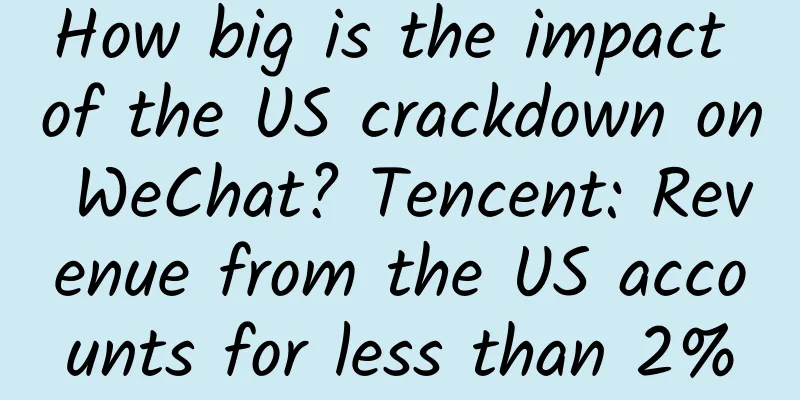How big is the impact of the US crackdown on WeChat? Tencent: Revenue from the US accounts for less than 2%

|
Yesterday, Tencent released its unaudited financial report for the second quarter and first half of 2020. The report showed that Tencent's revenue in the second quarter was 114.883 billion yuan, a year-on-year increase of 29%; during the period, the company's profit attributable to equity holders was 30.153 billion yuan, a year-on-year increase of 28%. In terms of specific business segments, value-added services still accounted for the majority of the total, accounting for 57%, with revenue from this segment growing 35% year-on-year to RMB 65 billion. Value-added services include online games and social networks, with the growth rate of the gaming business hitting a two-year high of 40%. In the social field where Tencent excels, WeChat is also accelerating its transformation from a social product to a digital economy product. In the second quarter, the combined monthly active users of WeChat and Wechat increased to 1.206 billion. Benefiting from the growth of advertising inventory and exposure in WeChat Moments, social and other advertising revenue increased by 27% to 15.262 billion yuan. Tencent also mentioned the situation in overseas markets, especially the US market which has attracted attention recently. In the earnings call after Tencent released its second quarter results, James Mitchell, Tencent's chief strategy officer and group senior executive vice president, said in response to analysts' questions that revenue from the United States accounted for less than 2% of total revenue, of which U.S. advertising revenue accounted for less than 1% of total advertising revenue. James Mitchell said that if you look closely at the ban, Trump's ban is clearly aimed at the WeChat app business covering the United States, so he does not think it will affect the company's advertising on Tencent's platform in China. Tencent has stressed the distinction between its WeChat service outside of China, which Trump’s executive order explicitly mentions, and a similar app used inside China. The distinction between WeChat and WeChat is crucial because the vast majority of Tencent’s revenue comes from within China. If its domestic messaging service is not disrupted, the impact on Tencent’s business is likely to be fairly minimal. “The focus of the executive order is on WeChat in the United States, not on other businesses in the United States,” Tencent Chief Financial Officer Lo Shuohan said on a call with investors, adding that he could not speculate further. “We are in the process of seeking further clarification from the United States.” |
<<: After the WeChat US ban, Tencent delivered a financial report that far exceeded expectations
>>: Tencent emphasizes the difference between WeChat and Wechat
Recommend
If there are no words like these on your down jacket, don’t buy it no matter how cheap it is! A very practical guide to choosing down jackets →
The weather is getting colder, and it is time to ...
Allergies, inflammation, skin diseases… Can we still take our children to the water park when it’s so “dirty”?
In the hot summer, the best way to cool off is to...
Community operation monetization: private domain traffic & user operation
Grasping private domain traffic construction and ...
Apple urgently releases iOS 14.7.1 official version to fix two major bugs
[[413605]] The official version of iOS 14.7.1 has...
91 Ten Articles: NIO’s first overseas stop is Norway, Wuling Hongguang is exported to Lithuania at a high price of 20,000 euros
1. Li Bin, founder, chairman and CEO of NIO, once...
Acea: EU new car registrations fell by 2.6% in January 2025
In January 2025, new car registrations in the EU ...
4 steps to execute and implement event operations
How to execute and implement a complex and large-...
Will an asteroid hit the Earth in 2032? The United Nations launches the Planetary Safety Protocol for the first time
According to a report on the website of El Spania...
A Tmall live broadcast of "Everyone complaining about Zheng Shengli" generated over 100 million orders in 90 minutes!
Recently, the marketing circle has been discussin...
Zhihu advertising promotion, Zhihu advertising process
Today I would like to share with you the content ...
Security experts recommend not installing these apps on your phone
In recent weeks, tech news headlines have been fi...
Testin Cloud Testing and Chukong Strategic Cooperation: Helping North American Developers Improve Game Quality
Testin, the world's largest real-device cloud...
HTC makes a comeback, and the spy photos of the tablet with a design similar to HTC One are exposed
[September 10 news] There were rumors that HTC wil...
What are the taboos for short videos to catch the attention of the public? Short videos correctly attract attention
You have been creating short videos for a while. ...
Tencent Advertising Game Industry July Buying Volume Monthly Report & Product Dynamics
This article shares with you Tencent’s July adver...



![[Creative Cultivation Program] Can intestinal flora be "contagious"? I love you, so I share my intestinal flora with you!](/upload/images/67f2412f48636.webp)





